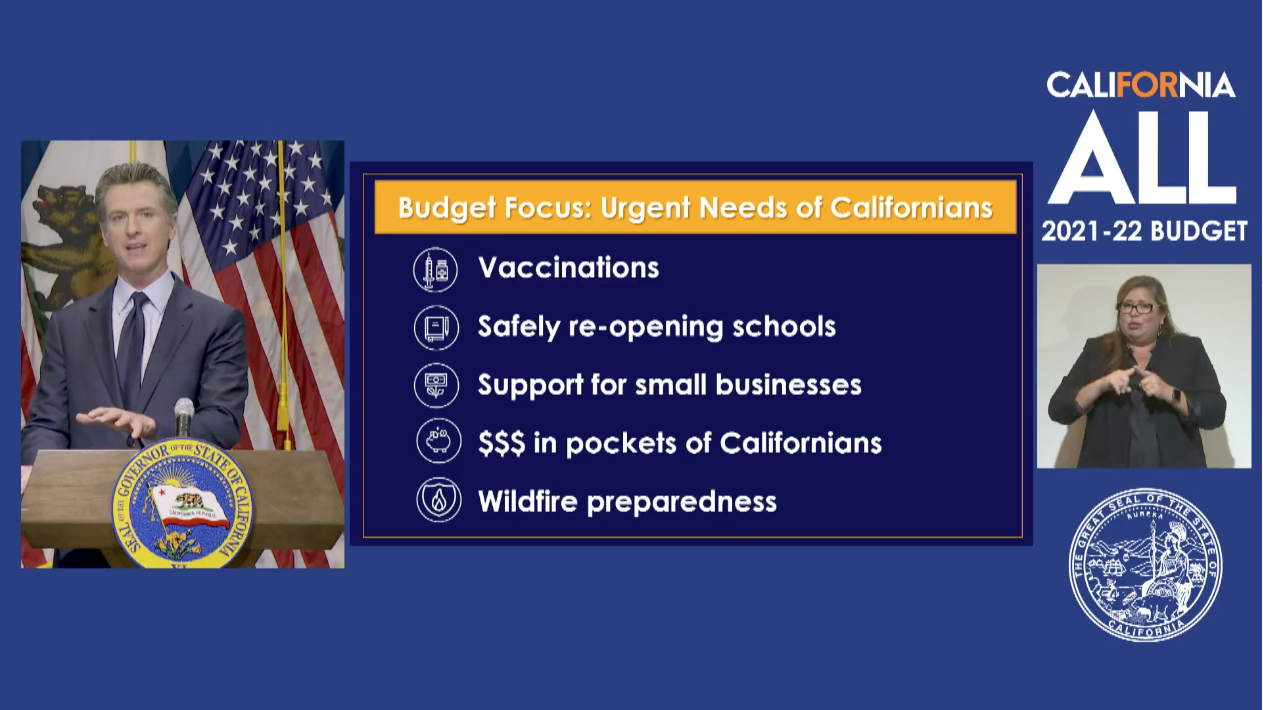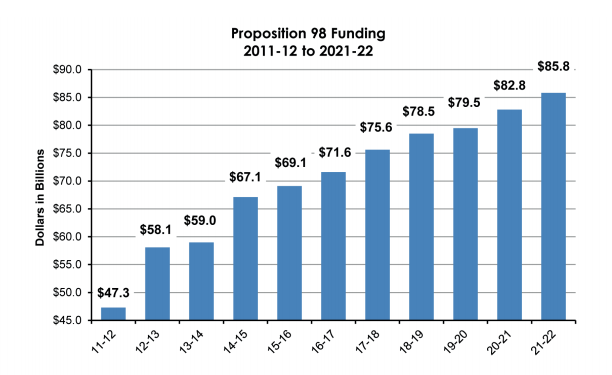
Governor Gavin Newsom unveiled his preliminary spending plan for 2021-22 on Friday, laying out a $227.2 billion blueprint that would increase funding for public health, schools and economic relief.
The proposed budget for the fiscal year that begins July 1 reflects both the governor’s priorities and an improved revenue outlook, fueled by the continued gains of California’s wealthiest taxpayers. But even though revenue looks healthy this year, fiscal experts are projecting a structural deficit beginning in 2022-23.
While Newsom’s spending plan serves as a starting point for lengthy fiscal deliberations, he is asking the Legislature to take swift action on a number COVID-19 relief packages, including school reopening grants.
Here are five takeaways:
***
K-14 education funding gets a boost.
Public schools would receive approximately $90 billion, with $85.8 billion guaranteed under Proposition 98. That represents the state’s highest-ever funding total for education.
New investments would target inequities caused by the pandemic, including $4.6 billion for districts to develop interventions that focus on students from low-income families, English learners, youth in foster care and students who are homeless. These could take the form of new summer and after-school programs. An additional $400 million would help pay for school-based mental health services. (More on that in a moment.)
In an effort to accelerate and support a return to in-person learning for elementary students, $2 billion in Proposition 98 funding has also been earmarked for the previously announced Safe Schools for All plan. Participating school districts would be able to pursue per-student grants by submitting detailed plans for bringing young learners back to campuses as early as mid-February. Increased testing and added personal protective equipment are among the requirements.
The budget would further set aside funds to pay down nearly two-thirds of this year’s deferrals — that’s state funding that was delayed when revenue fell — while providing a 3.84-percent cost-of-living adjustment over the next two years.
COVID-19 relief is intended to help families and business.
The governor’s plan allocates $14 billion in economic relief and recovery, including cash payments of $600 to low-income workers, and another $372 million to speed up the distribution of vaccines. Grants to small businesses and small non-profit cultural institutions disproportionately impacted by the pandemic would more than double to $575 million.
“In these darkest moments of the COVID-19 pandemic, this budget will help Californians with urgent action to address our immediate challenges and build towards our recovery,” Newsom said in a statement. “As always, our budget is built on our core California values of inclusion, economic growth and a brighter future for all.”
While the budget covers the fiscal year that starts in July, the governor is asking the Legislature to take swift action on a number of the COVID-19 packages, including his school reopening plan.
Mental health funding will target the hardest hit communities.
Addressing the trauma experienced by students during the pandemic, $400 million in one-time funding has been proposed for school-based mental health services. Populations disproportionately impacted would be prioritized, including low-income families, foster youth, homeless students and English learners.
The budget also includes $265 million to “develop a range of community school models that holistically address the needs of children.” In addition, $50 million would be invested in statewide resources and professional development on social emotional and trauma-informed practices, and $25 million would help fund partnerships between county behavioral health departments and school districts.
The budget expands transitional kindergarten.
Recognizing that the COVID-19 pandemic has disrupted the state’s child care system, the budget expands high-quality transitional kindergarten programs for 4-year-olds with $250 million in incentive funds for districts.
The budget also includes $200 million in one-time funding for transitional kindergarten and kindergarten facilities, along with $50 million for professional development aimed at preparing teachers for early childhood programs.
This is just the start of California’s budget negotiations.
Budget proposals in January mark the beginning of a process that goes on for months, but they also provide school districts and other public agencies with a foundation for developing their own plans.
Orange County Superintendent Dr. Al Mijares characterized the spending plan as “a positive first step.” Here’s his full statement:
We are pleased to see that education continues to be a top priority in the governor’s budget. At the same time, we recognize that this favorable revenue picture will not last forever, with deficits already projected for 2022-23. It is therefore imperative that we remain circumspect and not overcommit resources while making prudent investments both in the students who need to be brought up to grade level as well as those who need more opportunities to participate in the most challenging courses, including high-level career technical education.
I am encouraged that much of the new funding would follow students with the greatest needs, including youth who are homeless, those in foster care, students from low-income families and English learners. I am further heartened by the focus on early education, as we know the investments made before grade three are essential to long-term academic success. The governor’s budget would also allow our districts to provide increased support to meet the mental health needs of students whose lives have been disrupted by the pandemic.
Overall, I would characterize this spending plan as a positive first step, and I look forward to hearing additional details as discussions unfold in the months ahead.
The next fiscal milestone at the state level is May, when the governor will release a revised spending plan based on the latest economic data and projections.
More information on Gov. Newsom’s budget, including a full summary of his January proposal, is available at www.ebudget.ca.gov.

